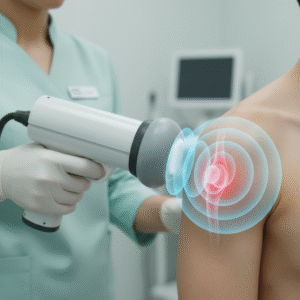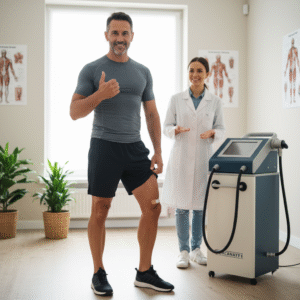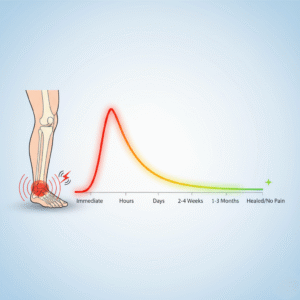When you’re experiencing chronic pain or muscle tension, every minute counts. That’s why many patients today turn to shockwave therapy, a scientifically backed treatment that promotes healing by stimulating blood flow and tissue repair. But one of the most common questions people ask is: “How long does it take for a shockwave to hit?”
While the name might sound immediate, shockwave therapy works in a carefully controlled way. The process involves mechanical waves of energy that reach deep tissues within milliseconds, yet the body’s healing response unfolds gradually over time.
This article breaks down what really happens when the shockwave hits, how soon you’ll notice results, and why professional shockwave treatment yields faster, longer-lasting relief than any at-home alternatives.

Understanding What a Shockwave Actually Is
Before we talk about timing, it’s important to understand what a shockwave is. Unlike electric or ultrasound waves, shockwaves are high-energy acoustic pulses. These waves travel faster than sound and penetrate deep into soft tissue, targeting areas affected by chronic inflammation, calcification, or scar tissue.
In a professional setting, a therapist uses a handheld applicator to deliver these shockwaves directly to the affected area. Each pulse triggers microtrauma, tiny, controlled injuries that stimulate the body’s natural healing response.
This leads to:
- Increased blood circulation
- New cell growth
- Breakdown of scar tissue and calcium deposits
- Accelerated tissue regeneration
So, while the shockwave hits your body instantly, its therapeutic effects build over time as your body responds to the treatment.
How Long Does It Take for a Shockwave to Hit During Treatment?
When the device is activated, shockwaves travel through the skin and into deeper tissues almost instantly, within microseconds. These waves typically penetrate between 3 to 6 centimeters deep, depending on the setting and the target area.
During each pulse, energy is released and absorbed by the tissues. The waves cause mechanical stress and vibration, which trigger your body’s biological healing mechanisms.
Each session lasts about 10 to 20 minutes, depending on the size of the treatment area. Within that short period, the machine may deliver 2,000 to 4,000 shockwave pulses, meaning thousands of “hits” occur during each session.
However, the real question isn’t how fast the wave travels; it’s how long until you feel the benefits.
When Do You Start to Feel Results from Shockwave Therapy?
Here’s where professional treatment truly matters. While the energy from each shockwave impacts your tissues immediately, symptom improvement happens in stages:
1. Immediate Response (During or Right After the Session)
Some patients report a mild numbing or light pain relief immediately after the session. This is due to the temporary desensitization of nerve endings and improved local blood flow.
2. Short-Term Healing Phase (1–3 Days After Treatment)
In the first few days, your body begins an inflammatory healing response; this is a good sign. It means the therapy is working. You may feel mild soreness similar to post-workout fatigue.
3. Noticeable Improvement (1–2 Weeks)
By this stage, blood circulation improves, tissue regeneration begins, and pain levels start to decrease. Many patients notice reduced stiffness and better range of motion.
4. Maximum Benefit (3–6 Weeks)
This is when the deeper healing occurs. Collagen production, tissue regeneration, and cellular recovery peak, leading to long-term pain relief and mobility restoration.
So while shockwaves hit instantly, the healing effect takes anywhere from a few days to several weeks, depending on your body’s response, the condition treated, and, most importantly, the quality of professional care.
Factors That Affect How Quickly You Feel Results
Several factors influence how long it takes for you to experience noticeable results after shockwave therapy:
1. The Condition Being Treated
Some conditions respond faster than others. For instance:
- Plantar fasciitis and tennis elbow often improve within 2–3 sessions.
- Tendon calcifications may take longer, 4–6 sessions or more.
- Chronic conditions that have developed over the years generally require more time.
2. Energy Levels and Frequency
The energy settings used during your session play a major role. Professionals carefully adjust intensity based on your comfort level and condition severity. Too little energy won’t penetrate deeply enough; too much can cause unnecessary irritation.
3. Your Body’s Healing Response
Everyone’s body heals differently. Factors like age, circulation, fitness level, and diet influence how quickly your tissues regenerate.
4. The Quality of Professional Equipment
Medical-grade shockwave devices deliver precise, controlled energy, unlike at-home devices or unregulated clinics. These machines are designed for optimal tissue penetration and safety, ensuring maximum efficiency with minimal discomfort.
5. Therapist Expertise
A professional therapist understands anatomy and pain patterns, ensuring energy is applied at the right angle, depth, and intensity. This precision makes a big difference in how quickly results appear.

DIY vs. Professional Shockwave Therapy: Why Expertise Matters
In recent years, many low-cost shockwave gadgets have entered the market, promising quick results at home. But here’s the truth: Shockwave therapy is not a DIY treatment.
Here’s why professional services are essential:
- Safety: A licensed therapist knows exactly where and how to apply the device to avoid nerve irritation or tissue damage.
- Accuracy: Professionals can identify the root cause of your pain rather than just treating the symptoms.
- Power and Calibration: Clinic-grade machines use controlled pressure and depth that consumer devices can’t match.
- Consistency: Professionals monitor your progress and adjust treatment parameters for long-term effectiveness.
So while you can technically buy a “shockwave gun” online, the results are nowhere near what you’d achieve under the care of a trained expert. In fact, improper use may delay healing or worsen pain.
What to Expect from a Professional Shockwave Therapy Session
If it’s your first time considering professional treatment, here’s what a typical session looks like:
- Initial Evaluation: Your therapist reviews your condition, pain level, and medical history.
- Target Mapping: The exact area of treatment is marked to ensure precision.
- Gel Application: A conductive gel helps transmit the shockwaves efficiently.
- Shockwave Delivery: The handheld applicator delivers thousands of pulses over 10–20 minutes.
- Aftercare Instructions: You may receive advice on hydration, gentle movement, or rest between sessions.
Most treatment plans involve 3–6 sessions spaced one week apart, depending on the condition’s severity and your healing response.
When to Seek Professional Help
If you’ve been struggling with chronic muscle or tendon pain, and rest or home remedies haven’t worked, it’s time to consult a licensed shockwave therapy provider.
Conditions that benefit most include:
- Plantar fasciitis
- Tennis elbow
- Shoulder tendinitis
- Achilles tendinopathy
- Muscle tension or myofascial pain
Delaying treatment can allow scar tissue and calcification to worsen, prolonging discomfort and reducing mobility.
Call to Action: Get Relief with Professional Shockwave Therapy in Rolling Meadows
Don’t wait for pain to control your day-to-day life. At our Rolling Meadows clinic, we specialize in safe, results-driven shockwave therapy designed to accelerate healing and restore movement. Our certified therapists use advanced technology and personalized care plans to help you recover faster, without surgery or long-term medication.
Call today to schedule your consultation and feel the difference that professional care makes. Experience the power of shockwave therapy the right way, safely, effectively, and backed by science.






